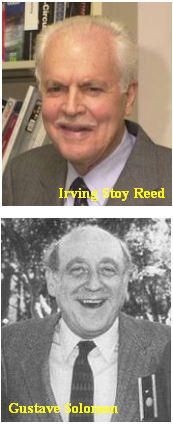Exercise 2.10Z: Code Rate and Minimum Distance
From LNTwww
The codes developed by Irving Stoy Reed and Gustave Solomon in the early 1960s are referred to in this tutorial as follows:
- RSC(n,k,dmin)q.
The code parameters have the following meanings:
- q=2m is an indication of the "size" of the Galois field ⇒ GF(q),
- n=q−1 is the "code length" (symbol number of a code word),
- k indicates the "dimension" (symbol number of an information block),
- dmin denotes the "minimum distance" between two code words.
- For any Reed-Solomon code:
- dmin=n−k+1.
No other code with the same k and n yields a larger value.
Hints:
- The exercise belongs to the chapter "Definition and Properties of Reed–Solomon Codes".
- Information relevant to this exercise can be found on the "Code name and code rate" page.
Questions
Solution
(1) From the code length n=255 follows q =256_.
- The code rate is given by R=223/255=0.8745_.
- The minimum distance is dmin=n−k+1=255−223+1=33_.
- This allows:
- e=dmin−1 =32_ symbol errors can be detected, and
- t=e/2 (rounded down). So t=16_ symbol errors can be corrected.
(2) The code RSC(2040,1784,dmin)2 is the binary representation of the RSC(255,223,dmin)256 discussed in (1)
- with exactly the same code rate R =0.8745_ and
- also the same minimum distance dmin =33_ as this one.
Here 8 bits (1 byte) are used per code symbol.
(3) From dmin=33 follows again t=16 ⇒ N3 =16_.
- If exactly one bit is falsified in each code symbol, this also means 16 symbol errors.
- This is the maximum value that the Reed–Solomon decoder can still handle.
(4) The Reed–Solomon decoder can correct 16 falsified code symbols.
- It does not matter whether in a code symbol only one bit or all m=8 bits have been falsified.
- Therefore, with the most favorable error distribution, up to N4=8⋅16 =128_ bits can be falsified without the code word being incorrectly decoded.
